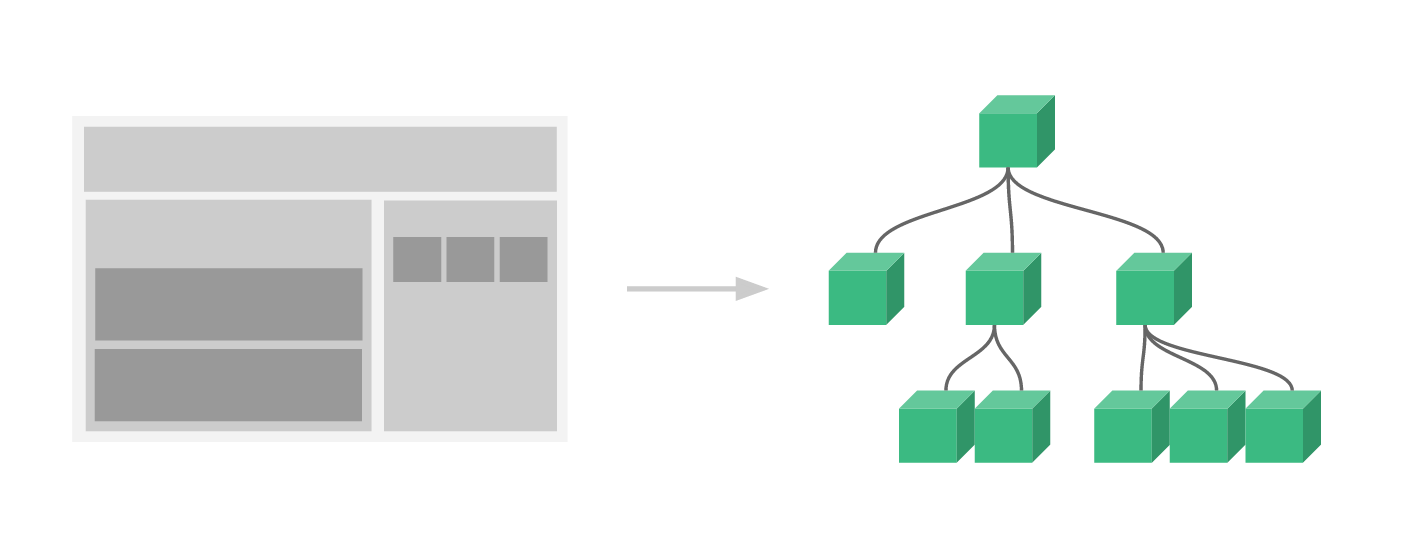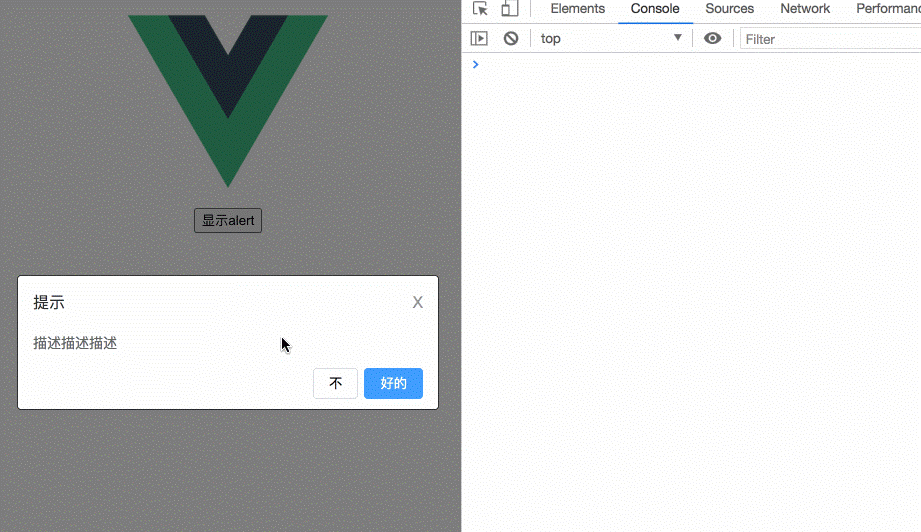标签:回调函数 项目 实现原理 option name 多次 提升 tee 复用
组件系统是 Vue 的一个重要概念,因为它是一种抽象,允许我们使用小型、独立和通常可复用的组件构建大型应用。几乎任意类型的应用界面都可以抽象为一个组件树。组件化能提高开发效率,方便重复使用,简化调试步骤,提升项目可维护性,便于多人协同开发。

父给子传值
// 父组件
<HelloWorld msg="Welcome to Your Vue.js App"/>
// 子组件
props: { msg: String }
子给父传值
// 父组件
<Cart @onAdd="cartAdd($event)"></Cart>
// 子组件
this.$emit(‘onAdd‘, data)
任意两个组件之间传值,Vue 中已经实现相应接口,下面是实现原理,其实也是典型的发布-订阅模式。
// Bus:事件派发、监听和回调管理
class Bus {
constructor() {
this.callbacks = {}
}
$on (name, fn) {
this.callbacks[name] = this.callbacks[name] || []
this.callbacks[name].push(fn)
}
$emit (name, args) {
if (this.callbacks[name]) {
this.callbacks[name].forEach(cb => cb(args))
}
}
}
// main.js
Vue.prototype.$bus = new Bus()
// 组件1
this.$bus.$on(‘add‘, handle)
// 组件2
this.$bus.$emit(‘add‘)
任意两个组件之间传值,创建唯一的全局数据管理者store,通过它管理数据并通知组件状态变更。vuex官网
兄弟组件之间通信可通过共同祖辈搭桥, $parent 或 $root 。
// 兄弟组件1
this.$parent.$on(‘foo‘, handle)
// 兄弟组件2
this.$parent.$emit(‘foo‘)
父组件可以通过 $children 访问子组件实现父子通信。
// 父组件
this.$children[0].xx = ‘xxx‘
需要注意
$children并不保证顺序,也不是响应式的。
$attrs 包含了父作用域中不作为 prop 被识别 (且获取) 的 attribute 绑定 (class 和 style 除外)。
// 父组件
<HelloWorld foo="foo"/>
// 子组件:并未在props中声明foo
<p>{{ $attrs.foo }}</p>
$listenners 包含了父作用域中的 (不含 .native 修饰器的) v-on 事件监听器。
// 父组件
<HelloWorld v-on:event-one="methodOne" />
// 子组件
created() {
console.log(this.$listeners) // { ‘event-one‘: f() }
}
一个对象,持有注册过 ref attribute 的所有 DOM 元素和组件实例。
<HelloWorld ref="hw" />
mounted() {
this.$refs.hw.xx = ‘xxx‘
}
以允许一个祖先组件向其所有子孙后代注入一个依赖。
// 祖先组件提供
provide () {
return { foo: ‘bar‘ }
}
// 后代组件注入
inject: [‘foo‘]
created () {
console.log(this.foo) // => "bar"
}
插槽语法是Vue 实现的内容分发 API,用于复合组件开发。该技术在通用组件库开发中有大量应用。
// comp
<div>
<slot></slot>
</div>
// parent
<comp>hello</comp>
将内容分发到子组件指定位置
// comp2
<div>
<slot></slot>
<slot name="content"></slot>
</div>
// parent
<Comp2>
<!-- 默认插槽用default做参数 -->
<template v-slot:default>具名插槽</template>
<!-- 具名插槽用插槽名做参数 -->
<template v-slot:content>内容...</template>
</Comp2>
分发内容要用到子组件中的数据
// comp3
<div>
<slot :foo="foo"></slot>
</div>
// parent
<Comp3>
<!-- 把v-slot的值指定为作用域上下文对象 -->
<template v-slot:default="slotProps"> 来自子组件数据:{{slotProps.foo}} </template>
</Comp3>
在Vue中我们可以使用 Vue.component(tagName, options) 进行全局注册,也可以是在组件内部使用 components 选项进行局部组件的注册。
全局组件是挂载在
Vue.options.components下,而局部组件是挂载在vm.$options.components下,这也是全局注册的组件能被任意使用的原因。
有一些全局组件,类似于Message 、Toast 、 Loading 、 Notification 、Alert 通过原型的方式挂载在 Vue 的全局上面。
下面来实现一个简单Alert 组件,主要是对思路的一个理解,先上效果图

@/components/alert/src/Alert.vue
<template>
<transition name="fade">
<div class="alert-box-wrapper" v-show="show">
<div class="alert-box">
<div class="alert-box-header">
<div class="alert-box-title">{{ title }}</div>
<div class="alert-box-headerbtn" @click="handleAction(‘close‘)">X</div>
</div>
<div class="alert-box-content">
<div class="alert-box-container">{{ message }}</div>
</div>
<div class="alert-box-btns">
<button class="cancel-btn" @click="handleAction(‘cancel‘)">{{ cancelText }}</button>
<button class="confirm-btn" @click="handleAction(‘confirm‘)">{{ confirmText }}</button>
</div>
</div>
</div>
</transition>
</template>
<script>
export default {
name: ‘Alert‘,
data () {
return {
title: ‘标题‘,
message: ‘这是一段提示内容‘,
show: false,
callback: null,
cancelText: ‘取消‘,
confirmText: ‘确定‘
}
},
methods: {
handleAction (action) {
this.callback(action)
this.destroyVm()
},
destroyVm () { // 销毁
this.show = false
setTimeout(() => {
this.$destroy(true)
this.$el && this.$el.parentNode.removeChild(this.$el)
}, 500)
}
}
}
</script>
<style lang="less" scoped>
.fade-enter-active, .fade-leave-active {
transition: opacity .3s;
}
.fade-enter, .fade-leave-to {
opacity: 0;
}
.alert-box-wrapper {
position: fixed;
top: 0;
bottom: 0;
left: 0;
right: 0;
display: flex;
justify-content: center;
align-items: center;
background: rgba(0, 0, 0, 0.5);
.alert-box {
display: inline-block;
width: 420px;
padding-bottom: 10px;
background-color: #fff;
border-radius: 4px;
border: 1px solid #303133;
font-size: 16px;
text-align: left;
overflow: hidden;
.alert-box-header {
position: relative;
padding: 15px;
padding-bottom: 10px;
.alert-box-title {
color: #303133;
}
.alert-box-headerbtn {
position: absolute;
top: 15px;
right: 15px;
cursor: pointer;
color: #909399;
}
}
.alert-box-content {
padding: 10px 15px;
color: #606266;
font-size: 14px;
}
.alert-box-btns {
padding: 5px 15px 0;
text-align: right;
.cancel-btn {
padding: 5px 15px;
background: #fff;
border: 1px solid #dcdfe6;
border-radius: 4px;
outline: none;
cursor: pointer;
}
.confirm-btn {
margin-left: 6px;
padding: 5px 15px;
color: #fff;
background-color: #409eff;
border: 1px solid #409eff;
border-radius: 4px;
outline: none;
cursor: pointer;
}
}
}
}
</style>
@/components/alert/index.js
import Alert from ‘./src/Alert‘
export default {
install (Vue) {
// 创建构造类
const AlertConstructor = Vue.extend(Alert)
const showNextAlert = function (args) {
// 实例化组件
const instance = new AlertConstructor({
el: document.createElement(‘div‘)
})
// 设置回调函数
instance.callback = function (action) {
if (action === ‘confirm‘) {
args.resolve(action)
} else if (action === ‘cancel‘ || action === ‘close‘) {
args.reject(action)
}
}
// 处理参数
for (const prop in args.options) {
instance[prop] = args.options[prop]
}
// 插入Body
document.body.appendChild(instance.$el)
Vue.nextTick(() => {
instance.show = true
})
}
const alertFun = function (options) {
if (typeof options === ‘string‘ || options === ‘number‘) {
options = {
message: options
}
if (typeof arguments[1] === ‘string‘) {
options.title = arguments[1]
}
}
return new Promise((resolve, reject) => {
showNextAlert({
options,
resolve: resolve,
reject: reject
})
})
}
Vue.prototype.$alert = alertFun
}
}
@/main.js
import Alert from ‘@/components/alert‘
Vue.use(Alert)
使用
this.$alert({
message: ‘描述描述描述‘,
title: ‘提示‘,
cancelText: ‘不‘,
confirmText: ‘好的‘
}).then(action => {
console.log(`点击了${action}`)
}).catch(action => {
console.log(`点击了${action}`)
})
// 或
this.$alert(‘描述描述描述‘, ‘提示‘).then(action => {
console.log(`点击了${action}`)
}).catch(action => {
console.log(`点击了${action}`)
})
想象一下,你在工作中接手一个项目,打开一个3000行的vue文件,再打开一个又是4000行,你燥不燥?一口老血差点喷上屏幕。
这个问题我觉得不太容易回答,每个人都有每个人的看法,题中的“组件”可能不仅限于Vue组件,广义上看,前端代码模块,独立类库甚至函数在编写时都应该遵循良好的规则。首先,我们看看组件的出现解决了什么问题,有哪些优点:
从这三个点出发,各个角度去看一看。
编程界的六字真言啊。不管什么编程语言,不管前端还是后端,无论是多具体的设计原则,本质上都是对这个原则的实践。
开发中,不管是 React 还是 Vue ,我们习惯把组件划分为业务组件和通用组件,而达到解耦,提高复用性行。在编写组件甚至是函数时,应该把相同的功能的部分放在一起(如:Vue3组合式API),把不相干的部分尽可能撇开。试想一下,你想修改某个组件下的一个功能,结果发现牵连了一堆其他模块,或者你想复用一个组件时,结果引入了其他无关的一堆组件。你是不是血压一下就到200了?
SOLID 是面向对象设计5大重要原则的首字母缩写,当我们设计类和模块时,遵守 SOLID 原则可以让软件更加健壮和稳定。我觉得它同样适用于组件的设计。
slot 插槽、mixins ;真香!标签:回调函数 项目 实现原理 option name 多次 提升 tee 复用
原文地址:https://www.cnblogs.com/mingme/p/14684477.html